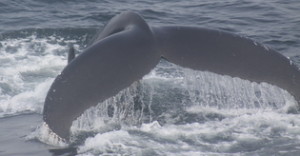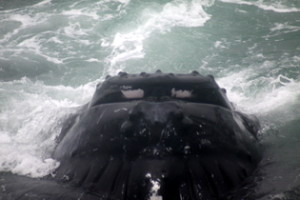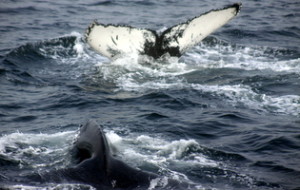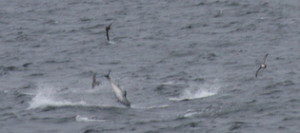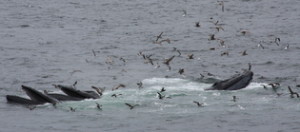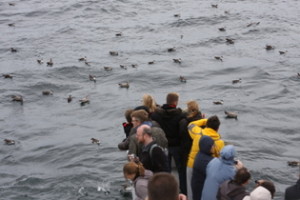Dolphin Fleet Naturalist Notebook – 3 October to 9 October
On October 3rd, all trips were cancelled due to high winds and rough seas, but by October 4th, we were ready to head back to Stellwagen Bank.

Although the skies were overcast, and the fog had not yet cleared, once we got to southern Stellwagen, we found that at least 9 humpbacks had come across a large school of fish. Longboard, a humpback whale named for the surfboard-shaped markings on the underside of its fluke, struck the water with its powerful tail, corralling the fish into tight bunches, and them lunging through the school, mouth agape.
Scientists still debate how whales locate patches of food in their environment. Like other animals, they might use a combination of sight, smell, and touch. One physiological feature of humpbacks that might help them to locate schools of fish are the the large hair follicles around their mouth and jaw. These grapefruit-sized protuberances are filled with sensitive nerve endings that might be stimulated when the hair encounters a patch of food.
When we returned in the afternoon and the fog had cleared. , the feeding had subsided, but the whales were still milling about. Citation, a humpback named for the bracket-shaped markings on the fluke, had joined up with Eruption and Condensation and could occasionally be seen lobtailing and tail breaching.
On October 5th, the sun came out and we headed back towards Stellwagen Bank. Eruption and Citation had moved westward, and Condensation had left the area completely. No feeding was occurring as far as we could tell, although we were lucky enough to encounter two mother and calf pairs. Rattan, and Chinook, two adult females, dove periodically, leaving their calves at the surface. While waiting for mom to return, Rattan’s calf would occasionally tail breach, sending a wall of spray into the air.
So far this season, there have been at least 46 mother and calf humpback whales identified in the Gulf of Maine. Compared to last year, when over 75 humpback calves returned to the area with their mothers, this number may seem low. However, sometimes mother and calves are not photographed and identified until late in the season. With all the nasty weather we’ve had this season, it is not inconceivable that we may have missed some of the mother and calf pairs passing through.
October 6th was another bright, sunny day, although the winds had picked up considerably. On our morning trip, we encountered Ganesh and her calf, swimming along the southern edge of Stellwagen Bank. It is the time of year when particularly precocious humpback whale calves might start to leave their mothers and venture off on their own. Other calves might stay with mom until the start of the next feeding season.
Taking a short respite from linear travel, Ganesh took a moment to tail breach, slamming her enormous fluke and tailstock down on the water. Despite years of observation, we still do not know exactly what this behavior means.
The next two days were too windy to whale watch, but on October 9th, we were ready to see how the weather had changed the marine scenery. Indeed, the storm seemed to have stirred up the nutrients off the eastern edge of Stellwagen. Everywhere we looked, huge groups of shearwaters dove down to the water to scoop up small fish right below the surface. Shearwaters are pelagic birds, meaning that they spend most of their lives at sea. They have some of the longest migrations on earth, travelling thousands of miles to the southern hemisphere to nest and breed on the rocky islands off the coast of Argentina. Like the whales, they favor the Gulf of Maine’s nutrient rich waters for their summer feeding season. Below, notice the shearwaters feeding on schools of small fish, as bluefin tuna leap out of the water as part of the feeding frenzy. They are both feeding on smaller fish, most likely to be sand lance.
Feeding shearwaters are often a sign of a good whale watch, as they indicate a food source that the whales might also be exploiting. Sure enough, as we steamed further to the east, we found that the humpbacks were enjoying a hearty mid-day meal. Trident, Wizard, Tear, and Division, among others, emerged with their heads out of the water, pushing the seawater out between their baleen plates, and swallowing thousands of small fish whole, only to do it again on the next breath.
The humpback whales don’t have much time before they have to abandon the food-rich waters of the North Atlantic in favor of the warmer waters of their mating grounds in the Caribbean. To make sure that they are prepared for their long journey, they must eat enough during the feeding season to sustain them through the winter.






